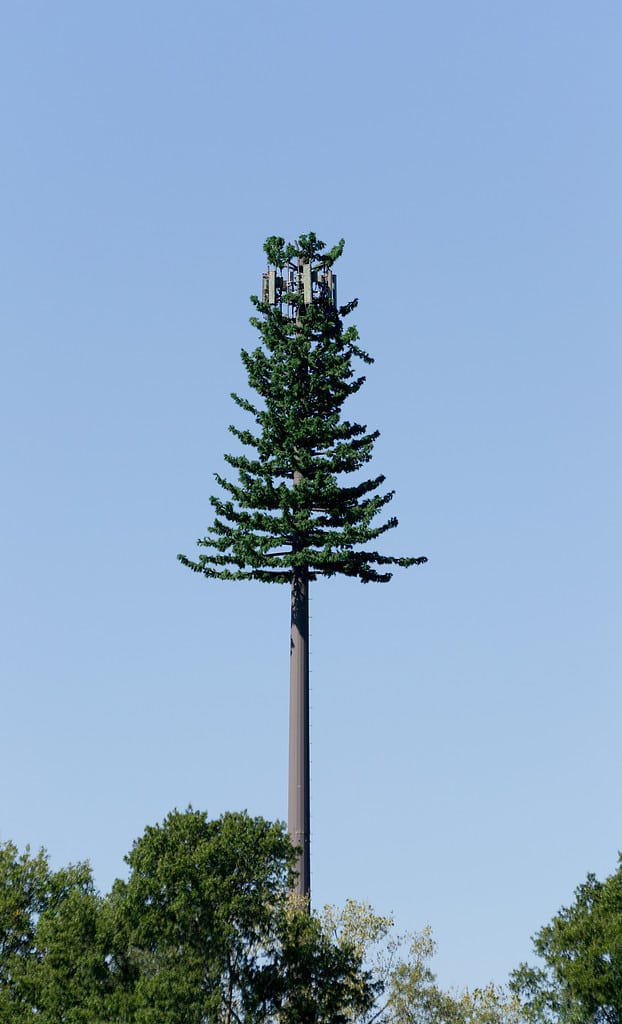Any city or suburban dweller will inevitably come in visual contact with a poorly camouflaged cell tower. These conspicuous towers come in many shapes and sizes, but they are sometimes roughly cloaked to look like trees despite almost always being much taller. Why are cell towers disguised as trees? We’ll look at some of the reasons now.
Why Are Cell Towers Disguised As Trees?

Cell towers are disguised as trees to distract from potential health risks and to make them less ugly.
©dmfoss/iStock via Getty Images
Cell towers are disguised as trees because many consider them unsightly, and they are associated with negative health risks. As a result, many communities, businesses, and municipalities are inclined to hide their towers from the public.
The general population is skeptical that living around cell towers is benign. There are fears that they cause diseases like cancer and some people view them as extremely unhealthy. This was the original driving force behind cell towers being decorated like pine trees, palm trees, cacti, and other plants.
Even when a cell tower dressed like a tree looks fake, their costuming is still considered effective. That’s because their silliness is associated with industrial art like that seen at amusement parks or in toy sets.
This effectively shifts the focus away from their potential health effects by making them seem whimsical instead of foreboding. If a viewer’s initial reaction is to guffaw and gossip about the aesthetics of the tower itself, the chances of hyperfocusing on the dangers of cell towers are reduced.
Pines are also cheaper to build than deciduous species because they don’t require as many parts. The more branches and leaves that are added to a cell tower, the stronger the tower has to be. Also, all of the fiberglass that goes into decorating a cell tower is costly so every additional piece drives up the overall price.
Do Cell Towers Cause Cancer?

While no one is sure that cell towers don’t cause cancer, they probably do not.
©This Lama/Shutterstock.com
Cell towers transmit and receive radio frequency waves (RF waves) which is what cell phones use to communicate. Since cellular technology is only a few decades old, the long-term effects of living near RF waves are still in question. As a result, official sources like the American Cancer Society do not have an established opinion on the risks of RF waves.
The concern arises from the worry that RF waves will disrupt human DNA causing cancer in the same way that gamma rays, UV rays, and X-rays can. However, RF waves do not affect DNA nor do they cause heat generation in the human body. Because of this, the consensus for now is that these waves are as harmless as microwaves and radio waves.
What is Visual Pollution?

Visual pollution is the idea that some manmade structures are damaging because they are not aesthetic.
Visual pollution refers to the concept that human inventions degrade the aesthetics of an environment. This is done by eliminating nature and animal ecosystems in human environments causing them to feel sterile. It also refers to the unappealing visuals created by any architecture that doesn’t adhere to any artistic principles.
The Telecommunications Act of 1996 in the United States banned local governments from stopping the construction of cell towers. This means that cell towers are built in historic districts or near areas untouched by manmade structures. As a result, the desire to mitigate visual pollution shifted from an avoidant NIMBY (Not in My Backyard) attitude toward the fake trees we see today.
Visual pollution is especially concerning in places like national parks. While some staff and patrons want the convenience of cellular technology, seeing cell towers in otherwise untouched environments can ruin the natural aesthetic. This is an ongoing problem, and how to handle it is still a contentious topic.
What Other Disguises Conceal Cell Towers?

Sometimes cell towers are disguised as a part of a church.
©Dan Barnes/iStock via Getty Images
Cell towers are often concealed by an architectural façade. For example, they may be constructed to look like water towers, windmills, flag poles, or light poles.
Churches sometimes rent their land to cellular companies as a means of securing an income source. As a result, some large cell towers are disguised as crosses, bell towers, or steeples. Cell companies do not face as many building regulations on church property in a lot of locations in the United States which makes these sites especially appealing.
The photo featured at the top of this post is © Merrimon/iStock via Getty Images
Thank you for reading! Have some feedback for us? Contact the AZ Animals editorial team.







